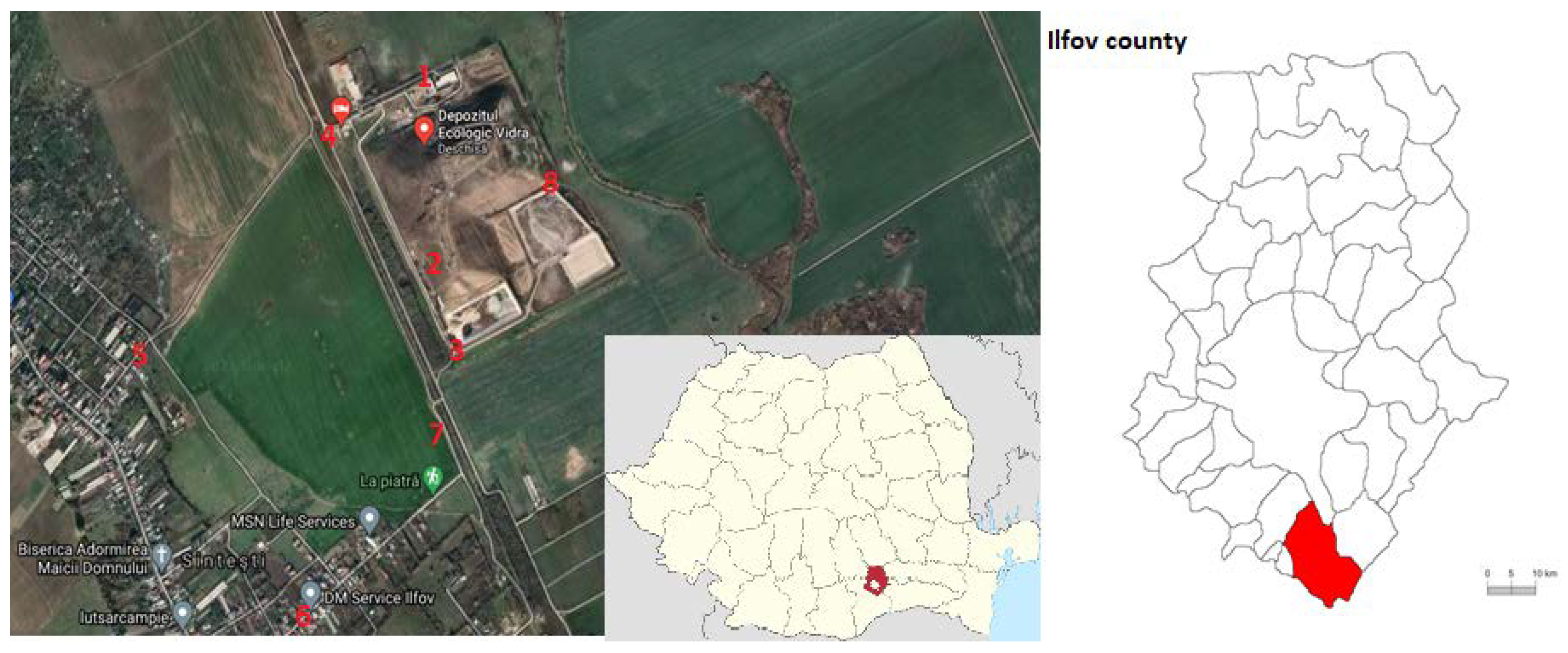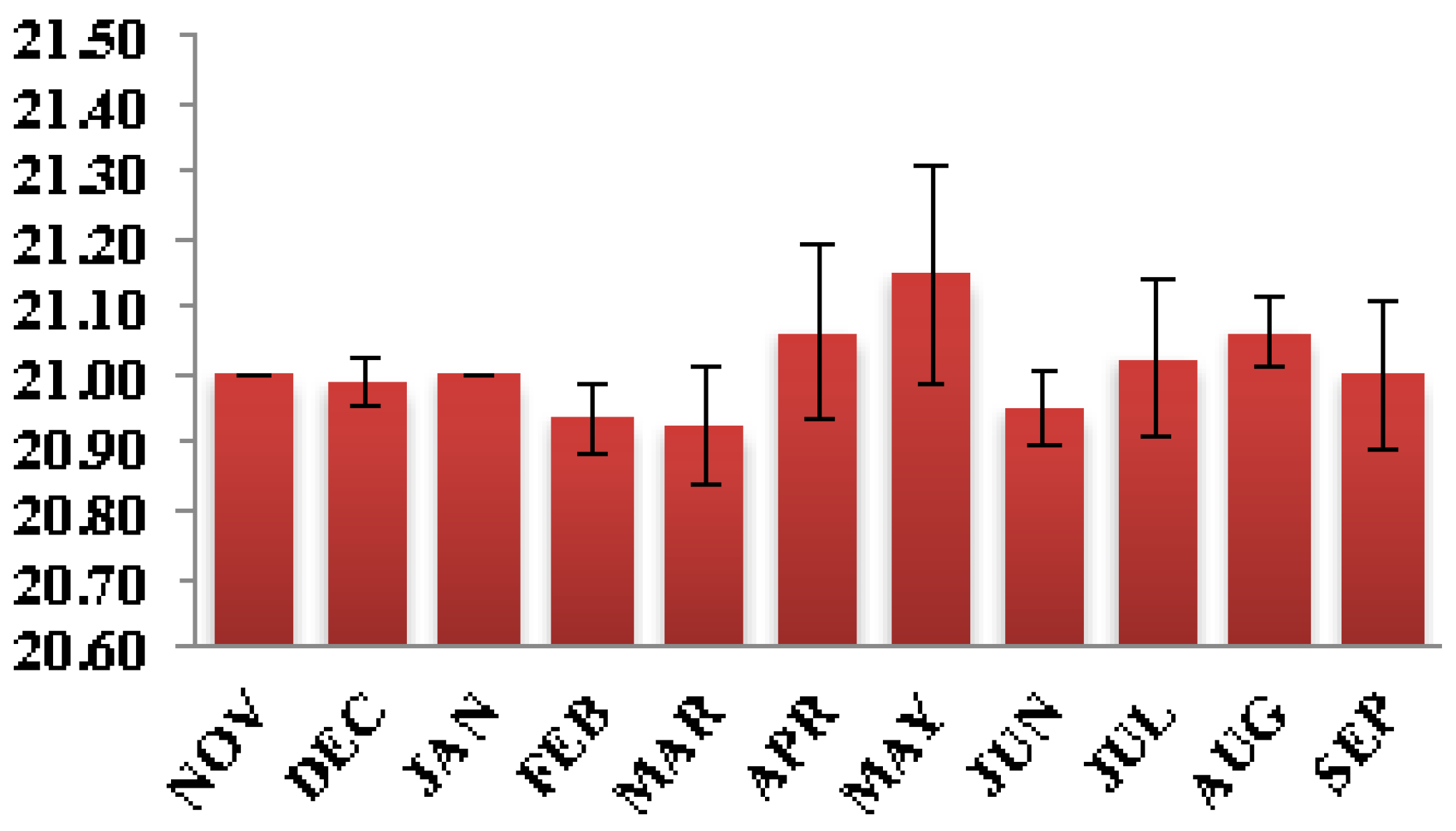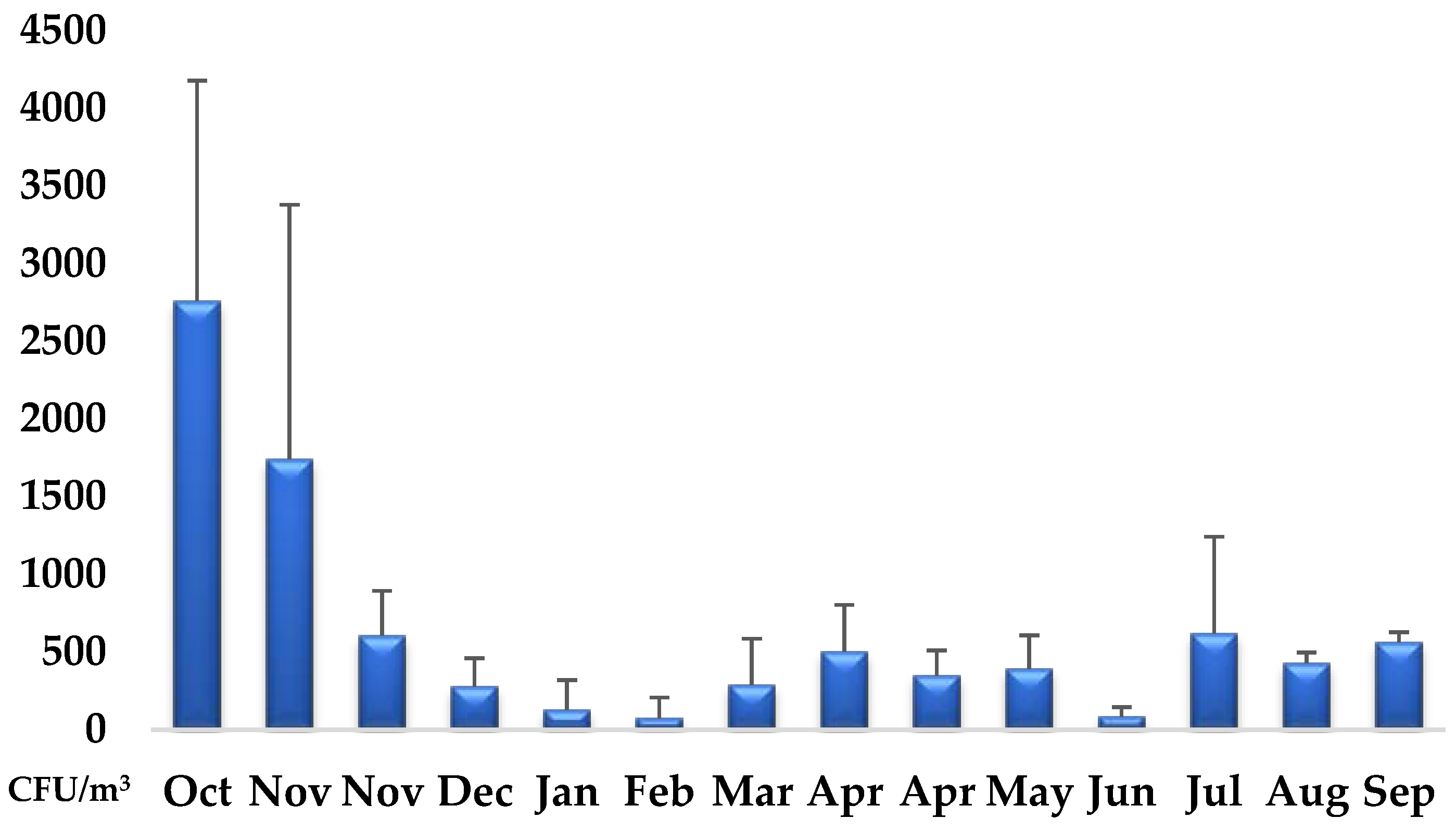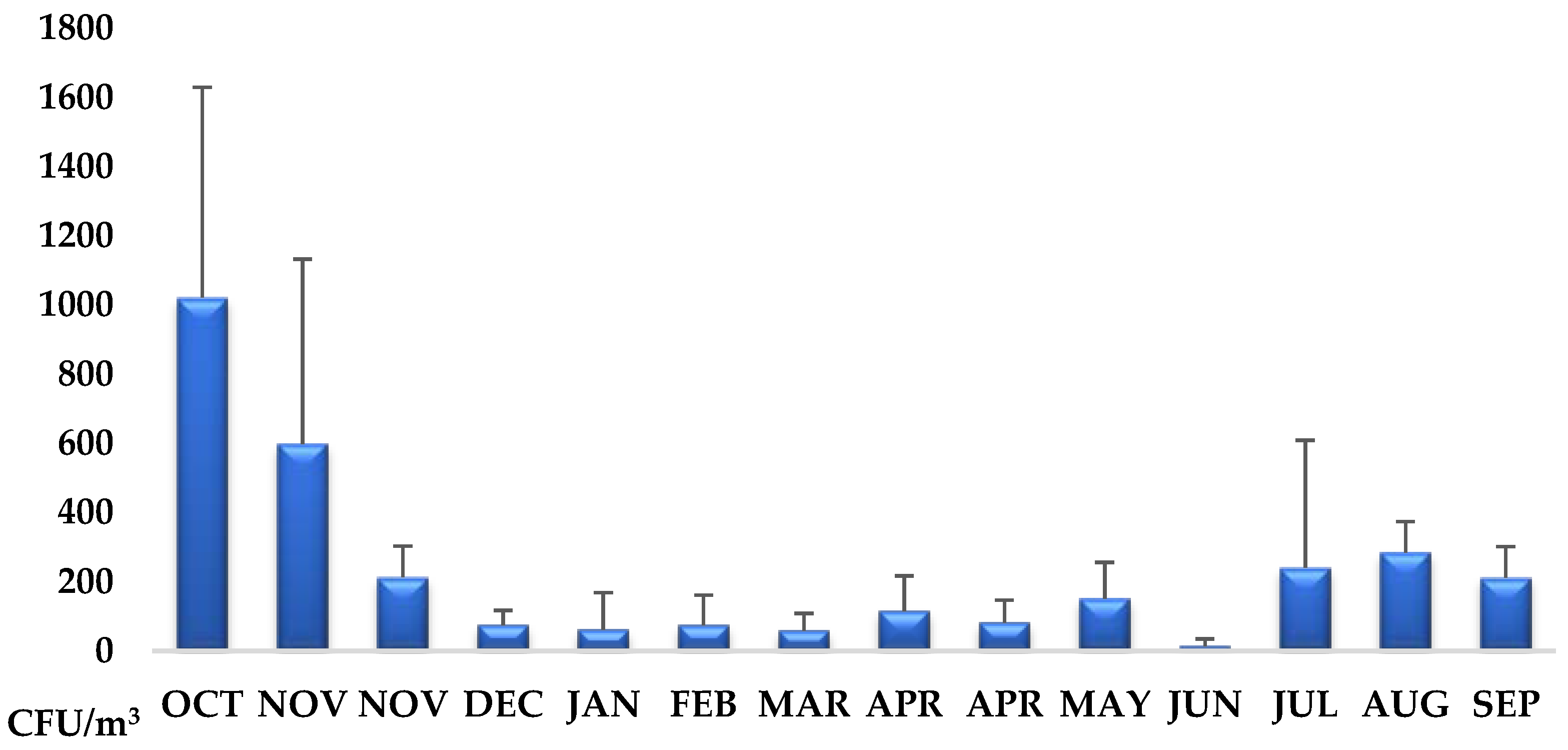Chemical and Microbiological Air Quality in a Municipal Solid Waste Landfill and Its Surroundings, in South-Eastern Romania
Abstract
1. Introduction
2. Materials and Methods
2.1. Description of the Study Location
2.2. Sampling Points and Period
- Sampling point 1–located inside the landfill on the concrete platform near the sorting station, N 44 31.893–E 26 12.623;
- Sampling point 2–located at the entrance of the active cell, direction S-W to inhabited area A, N 44 31.341–E 26 12.659;
- Sampling point 3–established on the property limit of the landfill, direction S-SW to inhabited area A, N 44 31.182–E 26 12.722;
- Sampling point 4–situated at the edge of the property, at the entrance gate for the garbage trucks, N 44 31.756–E 26 12.251;
- Sampling points 5 (N 44 31.174–E 26 11.492) and 6 (N 44 30.493–E 26 12.181)–set in the nearest inhabited rural area (A) (600 m), west, respectively south-west to the landfill.
- Sampling point 7–located as an intermediate point between the nearby inhabited area and the landfill, south to the landfill, N 44 30.948–E 26 12.710;
- Sampling point 8–established at the eastern property boundary of the landfill, in the direction of the second nearby inhabited area (B) (1000 m), N 44 31.613–E 26 13.36.
2.3. Sampling Procedure
2.4. Bacterial and Fungal Counts, Isolation and Identification
2.5. Statistical Analysis
3. Results
3.1. Atmospheric Oxygen and Chemical Pollutants Concentrations (CO2, H2S, NH3, CO and CH4)
3.2. Microbiological Air Quality–Aerobic Plate Count (APC), Total Fungal Count (TFC), Bacterial and Fungal Identification
4. Discussion
5. Conclusions
Author Contributions
Funding
Institutional Review Board Statement
Informed Consent Statement
Data Availability Statement
Acknowledgments
Conflicts of Interest
References
- Giusti, L. A review of waste management practices and their impact on human health. Waste Manag. 2009, 29, 2227–2239. [Google Scholar] [CrossRef] [PubMed]
- Forastiere, F.; Badaloni, C.; De Hoogh, K.; Von Kraus, M.K.; Martuzzi, M.; Mitis, F.; Palkovicova, L.; Porta, D.; Preiss, P.; Ranzi, A.; et al. Health impact assessment of waste management facilities in three European countries. Environ. Health 2011, 10, 53. [Google Scholar] [CrossRef] [PubMed]
- Mattiello, A.; Chiodini, P.; Bianco, E.; Forgione, N.; Flammia, I.; Gallo, C.; Pizzuti, R.; Panico, S. Health effects associated with the disposal of solid waste in landfills and incinerators in populations living in surrounding areas: A systematic review. Int. J. Public Health 2013, 58, 725–735. [Google Scholar] [CrossRef]
- Kaza, S.; Yao, L.C.; Bhada-Tata, P.; Van Woerden, F. What a Waste 2.0: A Global Snapshot of Solid Waste Management to 2050; World Bank Publications: Washington, DC, USA, 2018. [Google Scholar]
- Directive 2008/98/EC of the European Parliament and of the Council of 19 November 2008 on Waste and Repealing Certain Directives. Available online: https://eur-lex.europa.eu/legal-content/EN/TXT/PDF/?uri=CELEX:32008L0098&qid=1640251175490&from=EN (accessed on 15 December 2021).
- Burkowska, A.; Swiontek-Brzezinska, M.; Kalwasińska, A. Impact of the municipal landfill site on microbiological contamination of air. In Contemporary Problems of Management and Environmental Protection. Some Aspects of Environmental Impact of Waste Dumps. 2011, Volume 9, pp. 71–87. Available online: http://uwm.edu.pl/environ/vol09/vol09_chapter05.pdf (accessed on 1 December 2021).
- Elliott, P.; Richardson, S.; Abellan-Andres, J.J.; Thomson, A.; De Hoogh, C.; Jarup, L.; Briggs, D.J. Geographic density of landfill sites and risk of congenital anomalies in England. Occup. Environ. Med. 2008, 66, 81–89. [Google Scholar] [CrossRef] [PubMed]
- Aatamila, M.; Verkasalo, P.K.; Korhonen, M.J.; Suominen, A.L.; Hirvonen, M.-R.; Viluksela, M.K.; Nevalainen, A. Odour annoyance and physical symptoms among residents living near waste treatment centres. Environ. Res. 2011, 111, 164–170. [Google Scholar] [CrossRef] [PubMed]
- Heaney, C.D.; Wing, S.; Campbell, R.L.; Caldwell, D.; Hopkins, B.; Richardson, D.; Yeatts, K. Relation between malodor, ambient hydrogen sulfide, and health in a community bordering a landfill. Environ. Res. 2011, 111, 847–852. [Google Scholar] [CrossRef]
- Duan, Z.; Scheutz, C.; Kjeldsen, P. Trace gas emissions from municipal solid waste landfills: A review. Waste Manag. 2021, 119, 39–62. [Google Scholar] [CrossRef]
- US EPA. Emission Factor Documentation for AP-42 Section 2.4 Municipal Solid Waste Landfills Revised; Research Triangle Park: Durham, NC, USA, 1997.
- Canzano, S.; Salvestrini, S.; Iovino, P. Emission rate of non-methane volatile organic compounds from biodegradable domestic waste. Fresenius Environ. Bull. 2010, 19, 88–93. [Google Scholar]
- Blais-Lecours, P.; Perrott, P.; Duchaine, C. Non-culturable bioaerosols in indoor settings: Impact on health and molecular approaches for detection. Atmos. Environ. 2015, 110, 45–53. [Google Scholar] [CrossRef]
- Nair, A.T. Bioaerosols in the landfill environment: An overview of microbial diversity and potential health hazards. Aerobiologia 2021, 37, 185–203. [Google Scholar] [CrossRef]
- Pahren, H.R.; Clark, C.S. Microorganisms in municipal solid waste and public health implications. Crit. Rev. Environ. Control. 2009, 17, 187–228. [Google Scholar] [CrossRef]
- Gaspar, C.M.; Cocora, Z.M.; Brudiu, I.; Lazarescu, C.F.; Popovici, R.A.; Tigmeanu, C.V.; Tibru, I. Absorbent Food PADS from Meat Packages-Potential Source of Contamination. Rev. Chim. 2019, 70, 784–789. [Google Scholar] [CrossRef]
- Morar, A.; Sala, C.; Imre, K. Occurrence and antimicrobial susceptibility of Salmonella isolates recovered from the pig slaughter process in Romania. J. Infect. Dev. Ctries. 2015, 9, 99–104. [Google Scholar] [CrossRef][Green Version]
- Tîrziu, E.; Bărbălan, G.; Morar, A.; Herman, V.; Cristina, R.T.; Imre, K. Occurrence and Antimicrobial Susceptibility Profile of Salmonella spp. in Raw and Ready-To-Eat Foods and Campylobacter spp. in Retail Raw Chicken Meat in Transylvania, Romania. Foodborne Pathog. Dis. 2020, 17, 479–484. [Google Scholar] [CrossRef] [PubMed]
- Imre, K.; Herman, V.; Morar, A. Scientific Achievements in the Study of the Occurrence and Antimicrobial Susceptibility Profile of Major Foodborne Pathogenic Bacteria in Foods and Food Processing Environments in Romania: Review of the Last Decade. BioMed Res. Int. 2020, 2020, 5134764. [Google Scholar] [CrossRef] [PubMed]
- Kalwasińska, A.; Burkowska, A.; Brzezinska, M.S. Exposure of Workers of Municipal Landfill Site to Bacterial and Fungal Aerosol. CLEAN-Soil Air Water 2013, 42, 1337–1343. [Google Scholar] [CrossRef]
- Njoku, P.O.; Edokpayi, J.N.; Odiyo, J.O. Health and Environmental Risks of Residents Living Close to a Landfill: A Case Study of Thohoyandou Landfill, Limpopo Province, South Africa. Int. J. Environ. Res. Public Health 2019, 16, 2125. [Google Scholar] [CrossRef]
- Madhwal, S.; Prabhu, V.; Sundriyal, S.; Shridhar, V. Distribution, characterization and health risk assessment of size fractionated bioaerosols at an open landfill site in Dehradun, India. Atmos. Pollut. Res. 2019, 11, 156–169. [Google Scholar] [CrossRef]
- European Commission. The Environmental Implementation Review 2019—Country Report Romania. Brussels, 4.4.2019. SWD (2019) 130 Final. European Union. 2019. Available online: https://ec.europa.eu/environment/eir/pdf/report_ro_en.pdf (accessed on 15 December 2021).
- European Commission. Applying EU Law. Infringement Decisions. 2021. Available online: https://ec.europa.eu/atwork/applying-eu-law/infringements-proceedings/infringement_decisions/?lang_code=en (accessed on 15 December 2021).
- INS-Direcţia Judeţeană de Statistică ILFOV. 2021. Available online: https://ilfov.insse.ro/ (accessed on 15 December 2021).
- United States Department of Labor. Occupational Safety and Health Administration (OSHA). Occupational Safety and Health Standards—Respiratory Protection, Standard no. 1910.134. Available online: https://www.osha.gov/laws-regs/regulations/standardnumber/1910/1910.134 (accessed on 15 December 2021).
- Lee, U.; Han, J.; Wang, M. Evaluation of landfill gas emissions from municipal solid waste landfills for the life-cycle analysis of waste-to-energy pathways. J. Clean. Prod. 2017, 166, 335–342. [Google Scholar] [CrossRef]
- Lindsey, R. Climate Change: Atmospheric Carbon Dioxide. Available online: https://www.climate.gov/news-features/understanding-climate/climate-change-atmospheric-carbon-dioxide (accessed on 15 December 2021).
- Yue, D.; Han, B.; Sun, Y.; Yang, T. Sulfide emissions from different areas of a municipal solid waste landfill in China. Waste Manag. 2013, 34, 1041–1044. [Google Scholar] [CrossRef]
- Song, S.-K.; Shon, Z.-H.; Kim, K.-H.; Kim, S.C.; Kim, Y.-K.; Kim, J.-K. Monitoring of atmospheric reduced sulfur compounds and their oxidation in two coastal landfill areas. Atmos. Environ. 2007, 41, 974–988. [Google Scholar] [CrossRef]
- Kim, K.-H.; Baek, S.O.; Choi, Y.-J.; Sunwoo, Y.; Jeon, E.-C.; Hong, J.H. The Emissions of Major Aromatic Voc as Landfill Gas from Urban Landfill Sites in Korea. Environ. Monit. Assess. 2006, 118, 407–422. [Google Scholar] [CrossRef] [PubMed]
- Fang, J.-J.; Yang, N.; Cen, D.-Y.; Shao, L.-M.; He, P.-J. Odor compounds from different sources of landfill: Characterization and source identification. Waste Manag. 2012, 32, 1401–1410. [Google Scholar] [CrossRef] [PubMed]
- Lou, Z.; Wang, M.; Zhao, Y.; Huang, R. The contribution of biowaste disposal to odor emission from landfills. J. Air Waste Manag. Assoc. 2015, 65, 479–484. [Google Scholar] [CrossRef]
- Cheng, Z.; Sun, Z.; Zhu, S.; Lou, Z.; Zhu, N.; Feng, L. The identification and health risk assessment of odor emissions from waste landfilling and composting. Sci. Total Environ. 2018, 649, 1038–1044. [Google Scholar] [CrossRef]
- Fang, J.; Lü, F.; Zhang, H.; Shao, L.; He, P. Odor compounds released from different zones of two adjacent waste treatment facilities: Interactive influence and source identification. J. Air Waste Manag. Assoc. 2015, 65, 1446–1455. [Google Scholar] [CrossRef]
- Lim, J.-H.; Cha, J.-S.; Kong, B.-J.; Baek, S.-H. Characterization of odorous gases at landfill site and in surrounding areas. J. Environ. Manag. 2018, 206, 291–303. [Google Scholar] [CrossRef] [PubMed]
- Ko, J.H.; Xu, Q.; Jang, Y.-C. Emissions and Control of Hydrogen Sulfide at Landfills: A Review. Crit. Rev. Environ. Sci. Technol. 2015, 45, 2043–2083. [Google Scholar] [CrossRef]
- Breza-Boruta, B. The assessment of airborne bacterial and fungal contamination emitted by a municipal landfill site in Northern Poland. Atmos. Pollut. Res. 2016, 7, 1043–1052. [Google Scholar] [CrossRef]
- Kalwasińska, A.; Burkowska, A. Municipal landfill sites as sources of microorganisms potentially pathogenic to humans. Environ. Sci. Process. Impacts 2013, 15, 1078–1086. [Google Scholar] [CrossRef]
- Pagalilauan, H.A.M.; Paraoan, C.E.M.; Vital, P.G. Detection of pathogenic bioaerosols and occupational risk in a Philippine landfill site. Arch. Environ. Occup. Health 2017, 73, 107–114. [Google Scholar] [CrossRef] [PubMed]
- Breza-Boruta, B. Bioaerosols of the municipal waste landfill site as a source of microbiological air pollution and health hazard. Ecol. Chem. Eng. A 2012, 19, 851–862. [Google Scholar] [CrossRef]
- Schlosser, O.; Robert, S.; Debeaupuis, C. Aspergillus fumigatus and mesophilic moulds in air in the surrounding environment downwind of non-hazardous waste landfill sites. Int. J. Hyg. Environ. Health 2016, 219, 239–251. [Google Scholar] [CrossRef]
- Vilavert, L.; Nadal, M.; Figueras, M.J.; Domingo, J.L. Volatile organic compounds and bioaerosols in the vicinity of a municipal waste organic fraction treatment plant. Human health risks. Environ. Sci. Pollut. Res. 2011, 19, 96–104. [Google Scholar] [CrossRef] [PubMed]
- Cyprowski, M.; Ławniczek-Wałczyk, A.; Gołofit-Szymczak, M.; Frączek, K.; Kozdrój, J.; Górny, R. Bacterial aerosols in a municipal landfill environment. Sci. Total Environ. 2018, 660, 288–296. [Google Scholar] [CrossRef]
- Wikuats, C.F.H.; Duarte, E.H.; Prates, K.V.M.C.; Janiaski, L.L.L.; Gabriel, B.D.O.; Molina, A.D.C.; Martins, L.D. Assessment of airborne particles and bioaerosols concentrations in a waste recycling environment in Brazil. Sci. Rep. 2020, 10, 14812. [Google Scholar] [CrossRef]
- Frączek, K.; Kozdrój, J.; Górny, R.; Cyprowski, M.; Gołofit-Szymczak, M. Fungal air contamination in distinct sites within a municipal landfill area. Int. J. Environ. Sci. Technol. 2017, 14, 2637–2648. [Google Scholar] [CrossRef]
- Huang, C.-Y.; Lee, C.-C.; Li, F.-C.; Ma, Y.-P.; Su, H.-J.J. The seasonal distribution of bioaerosols in municipal landfill sites: A 3-yr study. Atmos. Environ. 2002, 36, 4385–4395. [Google Scholar] [CrossRef]
- Hameed, A.A.A.; Habeebuallah, T.; Mashat, B.; Elgendy, S.; Elmorsy, T.H.; Elserougy, S. Airborne fungal pollution at waste application facilities. Aerobiologia 2015, 31, 283–293. [Google Scholar] [CrossRef]
- Allmers, H.; Huber, H.; Baur, X. Two year follow-up of a garbage collector with allergic bronchopulmonary aspergillosis (ABPA). Am. J. Ind. Med. 2000, 37, 438–442. [Google Scholar] [CrossRef]
- Candela, S.; Ranzi, A.; Bonvicini, L.; Baldacchini, F.; Marzaroli, P.; Evangelista, A.; Luberto, F.; Carretta, E.; Angelini, P.; Sterrantino, A.F.; et al. Air Pollution from Incinerators and Reproductive Outcomes: A multisite study. Epidemiology 2013, 24, 863–870. [Google Scholar] [CrossRef] [PubMed]









| Sensor Name | Range/Detection Limits | Accuracy Over Full Measurement and Temperature Ranges | |
|---|---|---|---|
| Temperature Range | Accuracy | ||
|
O2 (electrochemical) | 0–30% vol | −20 °C to 55 °C | ±0.8% vol |
|
CO2 (infrared) | 0–5% | −20 °C to 55 °C | ±15.0% |
|
CH4 (infrared) | 0–100% LEL | −20 °C to 55 °C | ±15.0% |
| NH3 (electrochemical) | 0 to 500 ppm | −20 °C to 40 °C | ±15.0% |
| H2S (electrochemical) | 0 to 500 ppm | −20 °C to 55 °C | ±15.0% |
| CO (electrochemical) | 0 to 1500 ppm | −20 °C to 55 °C | ±15.0% |
Publisher’s Note: MDPI stays neutral with regard to jurisdictional claims in published maps and institutional affiliations. |
© 2021 by the authors. Licensee MDPI, Basel, Switzerland. This article is an open access article distributed under the terms and conditions of the Creative Commons Attribution (CC BY) license (https://creativecommons.org/licenses/by/4.0/).
Share and Cite
Pop, M.; Bucur, I.; Zoldan, D.; Imre, K.; Nichita, I.; Cristina, G.; Tîrziu, A.; Tîrziu, E. Chemical and Microbiological Air Quality in a Municipal Solid Waste Landfill and Its Surroundings, in South-Eastern Romania. Sustainability 2022, 14, 156. https://doi.org/10.3390/su14010156
Pop M, Bucur I, Zoldan D, Imre K, Nichita I, Cristina G, Tîrziu A, Tîrziu E. Chemical and Microbiological Air Quality in a Municipal Solid Waste Landfill and Its Surroundings, in South-Eastern Romania. Sustainability. 2022; 14(1):156. https://doi.org/10.3390/su14010156
Chicago/Turabian StylePop, Mirel, Iulia Bucur, Dan Zoldan, Kálmán Imre, Ileana Nichita, Gașpar Cristina, Andreea Tîrziu, and Emil Tîrziu. 2022. "Chemical and Microbiological Air Quality in a Municipal Solid Waste Landfill and Its Surroundings, in South-Eastern Romania" Sustainability 14, no. 1: 156. https://doi.org/10.3390/su14010156
APA StylePop, M., Bucur, I., Zoldan, D., Imre, K., Nichita, I., Cristina, G., Tîrziu, A., & Tîrziu, E. (2022). Chemical and Microbiological Air Quality in a Municipal Solid Waste Landfill and Its Surroundings, in South-Eastern Romania. Sustainability, 14(1), 156. https://doi.org/10.3390/su14010156







